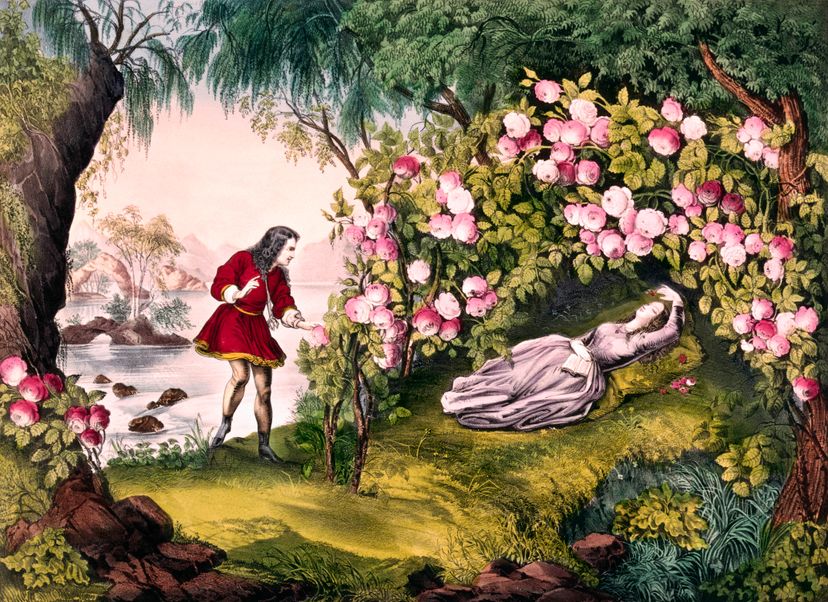
About This Quiz
Every culture has its fairy tales to teach and entertain, but you may be surprised to learn how the themes of these stories transcend borders. Take our quiz to see how much you know about tales from nations near and far.The adventures of Anna and Elsa in a little film called "Frozen" are based on a 19th-century tale by Hans Christian Andersen called "The Snow Queen."
The Danish tales focuses on the lives of a young girl named Gerda and her best friend, a boy named Kay.
In the fairy tale that inspired the much kid-friendlier Disney classic, the stepsisters chop off portions of their own feet to fit the glass slipper and eventually have their eyes pecked out by pigeons.
Advertisement
"Cinderella" is a German story written by the Brothers Grimm during the mid-19th century.
The early version of the Sleeping Beauty story originated with Basile of Naples in 17th century Italy. The sleepy princess in the tale was named Talia.
In the story, the prince heroically tracks down the sleeping princess, then rapes her. She eventually gives birth to twins, who wake her from her slumber by sucking a splinter out of her finger.
Advertisement
"Pinocchio" was written by Italian Carlo Collodi in 1881. The original story ends with Pinocchio being hung from an oak tree.
In the original story, Pinocchio gets tired of the talking cricket acting as his conscience, so he smashes the cricket with a hammer.
The oldest written scraps of this collection of Arabic tales dates back to the 9th century.
Advertisement
"Aladdin" is one of those rare fairy tales with a happy ending. Aladdin ends up rich, marries the sultan's daughter and lives happily ever after.
In another tale from "The Thousand and One Nights," Ali Baba outsmarts 40 thieves in order to steal the treasure they've hidden in a cave.
The thieves hide in oil jars, where they are killed when Morgiana pours hot oil into the jars.
Advertisement
Sinbad, or Sindbad the Sailor, must complete seven dangerous voyages in Basra, or modern Iraq.
Beaumont wrote "Beauty and the Beast" in the 18th century. The story is similar to modern versions of the tale, except in the story, Beauty has two sisters who get turned into stone thanks to their wicked ways.
In the Danish fairy tale, an old witch gives Thumbelina's mother a barley seed, which eventually grows to form a tiny girl.
Advertisement
This 19th century tale comes from Danish fairy tale master Hans Christian Andersen.
Sorry, Disney. In the fairy tale, the prince marries someone else, and the poor mermaid is turned into sea foam.
Hansel and Gretel trick the witch to get her into the oven, then cook her so they can escape (to the parents that abandoned them in the woods).
Advertisement
In Aesop's tale "The Ant and the Grasshopper," the ants work hard to prepare for winter, while the grasshopper fails to stock up for the coming cold weather.
Asbjornsen and Moe were the Brothers Grimm of Norway, who compiled classic Scandinavian fairy tales in the 19th century.
Italian Giambattista Basile penned this 17th-century tale of the princess who was destined to wed a man with golden hair and teeth.
Advertisement
In this tale by the Brothers Grimm, a cat, hound, rooster and donkey travel to Bremen Town to find careers as musicians.
Many Norwegian stories focus on either Draugen the sea ghost or his inland counterpart, Nixie the river sprite.
Tom Thumb ends up inside of a wolf but is rescued when his father cuts the wolf open to free him.
Advertisement
In the German fairy tale, the dwarves are unnamed. The silly names they are associated with today are strictly a Disney creation.
The wicked queen in the story is invited to Snow White's wedding, where she is forced to dance to death in hot iron shoes.
In this Hans Christian Andersen tale, a gullible emperor parades naked through town after being swindled into buying invisible clothes.
Advertisement
The Grimm version of the story is much grimmer. Rapunzel is cast out into the desert, where she gives birth to twins. The prince ends up blind and must wander the desert for years to track down his family.
In this Mexican fairy tale, a young girl agrees to marry a bear in order to save the lives of her family.
After turning chicken bones into gold, the frog-woman is killed when a flying chicken bone hits her in the head.
Advertisement